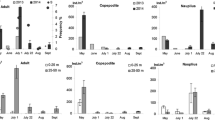Abstract
The n-3 polyenoic fatty acids (phytoplankton origin) dominate in the fatty acid composition of seston, which is a food source for bivalves; this indicates the predominance of diatoms in the seston composition. The distribution of the main classes of lipids and their fatty acids in the tissues of blue mussels depends on the mollusk body size. As the body size of the mollusk increases, the ratio of membrane lipids decreases, and high-energy saturated and monounsaturated fatty acids accumulate in storage lipids. The bulk of the n-3 polyenoic acids consumed by mollusks in seston (i.e., their food) accumulates in the tissues of mollusks and is used for their metabolism, whereas the long-chain saturated fatty acids, oleic acid and the n-6 polyenoic acids, are excreted with faecal pellets.


Similar content being viewed by others
REFERENCES
Newell, R.I.E., Ecosystem influences of natural and cultivated populations of suspension-feeding bivalve molluscs: a review, J. Shellfish Res., 2004, vol. 23, no. 1, pp. 51–62.
Alimov, A. F., Elementy teorii funktsionirovaniya vodnykh ekosistem (Elements of the Theory of Aquatic Ecosystem Functioning), Moscow: Nauka, 2000.
Dalsgaard, J., John, M.S., Kattner, G., et al., Fatty acid trophic markers in the pelagic marine environment, Adv. Mar. Biol., 2003, vol. 46, pp. 225–340. https://doi.org/10.1016/S0065-2881(03)46005-7
De Troch, M., Boeckx, P., Cnudde, C., et al., Bioconversion of fatty acids at the basis of marine food webs: insights from a compound-specific stable isotope analysis, Mar. Ecol. Progr. Ser., 2012, vol. 465, pp. 53–67. https://doi.org/10.3354/meps09920
Napolitano, G.E., Fatty acids as trophic and chemical markers in freshwater ecosystems, in Lipids in Freshwater Ecosystems, New York: Springer, 1999, pp. 21–44. https://doi.org/10.1007/978-1-4612-0547-0_3
Tiselius, P., Hansen, B.W., and Calliari, D., Fatty acid transformation in zooplankton: from seston to benthos, Mar. Ecol. Progr. Ser., 2012, vol. 446, pp. 131–144. https://doi.org/10.3354/meps09479
Irisarri, J., Fernández-Reiriz, M.J., De Troch, et al., Fatty acids as tracers of trophic interactions between seston, mussels and biodeposits in a coastal embayment of mussel rafts in the proximity of fish cages, Comp. Biochem. Physiol., Part B: Biochem. Mol. Biol., 2014, vol. 172, pp. 105–115. https://doi.org/10.1016/j.cbpb.2014.04.006
Fokina, N.N., Ruokolainen, T.R., and Nemova, N.N., The effect of intertidal habitat on seasonal lipid composition changes in blue mussels, Mytilus edulis L., from the White Sea, Polar Record, 2018, vol. 54, no. 2, pp. 133–151https://doi.org/10.1017/S0032247418000293
Müller-Navarra, D.C., Food web paradigms: the biochemical view on trophic interactions, Int. Rev. Hydrobiol., 2008, vol. 93, nos. 4–5, pp. 489–505.https://doi.org/10.1002/iroh.200711046
Smith, G.G., Thompson, P.A., Ritar, A.J., et al., Effects of starvation and feeding on the fatty acid profiles of stage I phyllosoma of the spiny lobster, Jasus edwardsii, Aquacult. Res., 2003, vol. 34, no. 5, pp. 419–426. https://doi.org/10.1046/j.1365-2109.2003.00825.x
Langdon, C.J. and Waldock, M.J., The effect of algal and artificial diets on the growth and fatty acid composition of Crassostrea gigas spat, J. Mar. Biol. Assoc. U. K., 1981, vol. 61, no. 2, pp. 431–448. https://doi.org/10.1017/S0025315400047056
Funding
The work was performed within the framework of state assignments nos. 0218-2019-0076 (no. АААА-А17-117031710039-3) and АААА-А19-119022690122-5.
Author information
Authors and Affiliations
Corresponding author
Ethics declarations
Conflict of interest. The authors declare that they have no conflict of interest.
Statement on the welfare of animals. All applicable international, national, and/or institutional guidelines for the care and use of animals were followed.
Additional information
Translated by M. Batrukova
Rights and permissions
About this article
Cite this article
Fokina, N.N., Ruokolainen, T.R., Nemova, N.N. et al. Fatty Acids Distribution in Seston, Tissues, and Faecal Pellets of Blue Mussels Mytilus edulis L.. Dokl Biochem Biophys 495, 311–318 (2020). https://doi.org/10.1134/S1607672920060046
Received:
Revised:
Accepted:
Published:
Issue Date:
DOI: https://doi.org/10.1134/S1607672920060046




